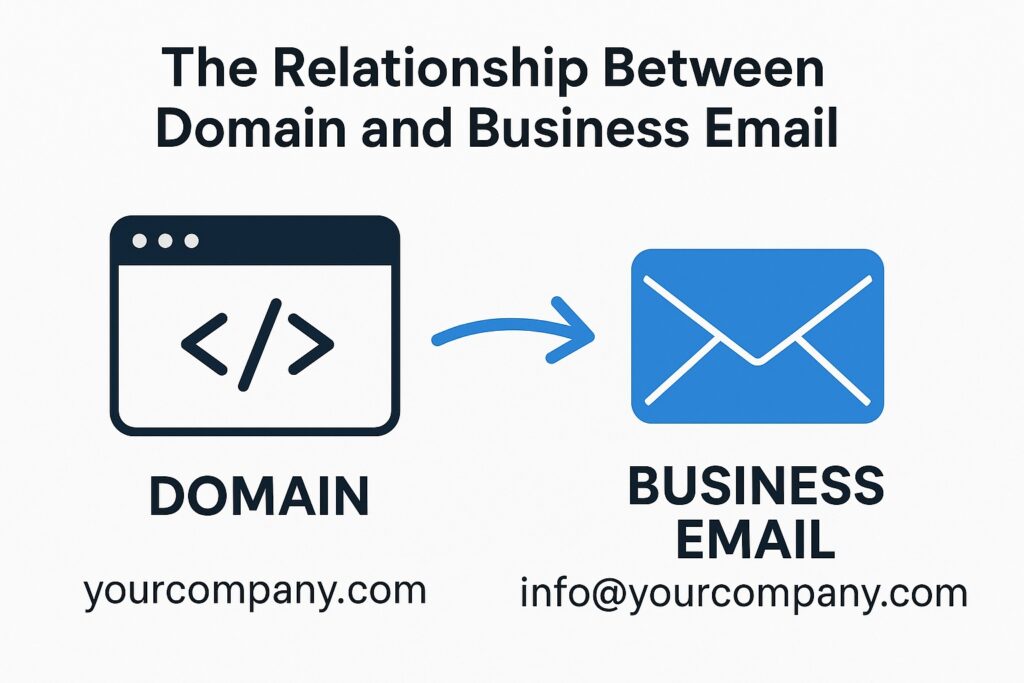A domain and a business email are two distinct but interconnected components of a professional online presence.
Your domain = your business’s digital address.
Your business email = your professional communication channel built on that domain.
What is a Domain?
A domain name is your unique address on the internet. It’s the part that comes after “www.” in a website URL, like yourbusiness.com.
Think of it as your digital real estate or the name of your building.
- Purpose: It identifies your website and allows people to find you online.
- Examples:
google.com,amazon.com,wikipedia.org.
What is a Business Email?
A business email is a professional email address that uses your company’s domain name, like contact@yourbusiness.com or firstname.lastname@yourbusiness.com.
Think of this as a specific office or a mailbox within your building.
- Purpose: It provides a credible and professional way to communicate with clients, partners, and employees.
- Contrast: It’s different from a generic free email address like
yourbusinessname@gmail.comoryourbusinessname@yahoo.com.
The Relationship Between Domain and Business Email
A business email cannot exist without a domain name. The domain name is the “address” that hosts your professional email.
When you create a business email, the part after the “@” symbol is your domain. This connection is what makes the email address look professional and trustworthy.
How to Set Up a Domain and Business Email
- Get a Domain Name: If you don’t have one, you’ll need to register a domain name that is easy to remember, spell, and is relevant to your business.
- Choose an Email Hosting Provider: You need a service to host and manage your email accounts. Many businesses use services that bundle email with other productivity tools. The most popular options are:
- Google Workspace: Provides a business-grade version of Gmail, Google Drive, Docs, Calendar, and Meet.
- Microsoft 365: Offers Outlook for email, along with Word, Excel, PowerPoint, and Teams.
- Zoho Mail: A good, more affordable option for businesses that need a clean, secure email service.
- Many web hosting companies also offer email hosting plans.
- Connect Your Domain: Once you have a domain and an email hosting plan, you’ll need to configure your domain’s DNS settings, specifically the MX records, to point to your email provider. Your provider will give you specific instructions on how to do this.
- Create Your Accounts: After the connection is set up, you can create individual email addresses for yourself and your team members. You can also create departmental aliases like
sales@yourbusiness.comorsupport@yourbusiness.comthat forward to specific individuals or teams.
Best Practices for Domain and Business Email
- Keep it simple: Choose a domain name that is easy to remember and type.
- Be consistent: Use a consistent naming convention for all employee emails (e.g.,
firstname@yourbusiness.comorfirstinitial.lastname@yourbusiness.com). - Secure your domain: Enable two-factor authentication and regularly monitor your domain’s health to prevent security risks.
- Authenticate your email: Set up security protocols like SPF, DKIM, and DMARC to prove that your emails are legitimate. This is critical for preventing your emails from being flagged as spam and for protecting your brand from phishing attacks.
- Warm up new domains: If you’re sending marketing emails, gradually increase your sending volume on a new domain to build a positive reputation with email service providers.
Your business will look better than ever. Earn your customers’ trust with a professional email address that matches your business name.
It can take a few minutes to set up an email address.
Receive only the email you want!
✅ Get a Professional Email Account for Business and Personal Use!

